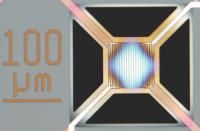MIT reels in RNA surprise with microbial ocean catch
An ingenious new method of obtaining marine microbe samples while preserving the microbes' natural gene expression has yielded an unexpected boon: the presence of many varieties of small RNAs — snippets of RNA that act as switches to regulate gene expression in these single-celled creatures. Before now, small RNA could only be studied in lab-cultured microorganisms; the discovery of its presence in a natural setting may make it possible finally to learn on a broad scale how microbial communities living at different ocean depths and regions respond to environmental stimuli.
"Microbes are exquisite biosensors," said Edward Delong, a professor of civil and environmental engineering (CEE) and biological engineering. "We had developed this methodology to look at protein-encoding genes, because if we know which proteins the microbes are expressing under what conditions, we can learn about the environmental conditions and how these microbes influence those. The unexpected presence and abundance of these small RNAs, which can act as switches to regulate gene expression, will allow us to get an even deeper view of gene expression and microbial response to environmental changes.
DeLong and co-authors Yanmei Shi, a graduate student in CEE, and postdoctoral associate Gene Tyson describe this work in Nature . The team used a technique called metatranscriptomics, which allows them to analyze the RNA molecules of wild microbes, something that previously could be done only with lab-cultured microbes.
Microbes are ultra-sensitive environmental sensors that respond in the blink of an eye to minute changes in light, temperature, chemicals or pressure and modify their protein expression accordingly. But that sensitivity creates a quandary for the scientists who study them. Sort of like the observer effect in quantum physics, by entering the environment or removing the microbes from it, the observer causes the microbes to change their protein expression. That same sensitivity makes some of these creatures exceedingly difficult to grow in lab cultures.
To overcome the hurdle of quickly collecting and filtering microbial samples in seawater before the microbes change their protein expression, the research team — collaboratively with CEE Professor Sallie (Penny) Chisholm and her research team, which has successfully grown and studied the photosynthetic microbe, Prochlorococcus, in the lab — created a method for amplifying the RNA extracted from small amounts of seawater by modifying a eukaryotic RNA amplification technique. When Shi began lab studies of the RNA in their samples, she found that much of the novel RNA they expected to be protein-coding was actually small RNA (or sRNA), which can serve as a catalyst or regulator for metabolic pathways in microbes.
"What's surprising to me is the abundance of novel sRNA candidates in our data sets," said Shi. "When I looked into the sequences that cannot be confidently assigned as protein-coding, I found that a big percentage of those sequences are non-coding sequences derived from yet-to-be-cultivated microorganisms in the ocean. This was very exciting to us because this metatranscriptomic approach — using a data set of sequences of transcripts from a natural microbial community as opposed to a single cultured microbial strain — opens up a new window of discovering naturally occurring sRNAs, which may further provide ecologically relevant implications."
"Being able to track the dynamics of small RNA expression in situ provides insight into how microbes respond to environmental changes such as nutrient concentration and physical properties like light and pressure," said Shi. "A very interesting question to follow up in the lab is how much fitness advantage a small RNA confers to microbes. Can the microbes with a specific small RNA perform better in competing for nutrients in a tough situation, for instance? The discovery of naturally occurring small RNAs is a first step towards addressing such questions."
Most read news
Other news from the department science
These products might interest you

Octet R2 / Octet R4 / Octet R8 by Sartorius
Full power on 2, 4 or 8 channels: Label-free and GxP-compliant analysis of molecular interactions
Innovative label-free real-time protein quantification, binding kinetics and rapid screenings

Octet RH16 and RH96 by Sartorius
Efficient protein analysis for process optimisation and manufacturing control in high-throughput
Label-free protein quantification and characterization of protein-protein interactions

Octet SF3 by Sartorius
Surface Plasmon Resonance (SPR) using Single Dynamic Injections for Kinetics and Affinities
Curvature is Key - Adding a ‘Third Dimension’ to the Binding Curve

Get the analytics and lab tech industry in your inbox
By submitting this form you agree that LUMITOS AG will send you the newsletter(s) selected above by email. Your data will not be passed on to third parties. Your data will be stored and processed in accordance with our data protection regulations. LUMITOS may contact you by email for the purpose of advertising or market and opinion surveys. You can revoke your consent at any time without giving reasons to LUMITOS AG, Ernst-Augustin-Str. 2, 12489 Berlin, Germany or by e-mail at revoke@lumitos.com with effect for the future. In addition, each email contains a link to unsubscribe from the corresponding newsletter.





















































